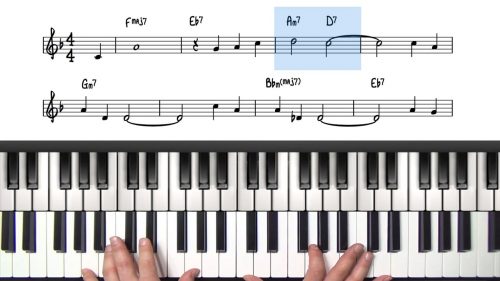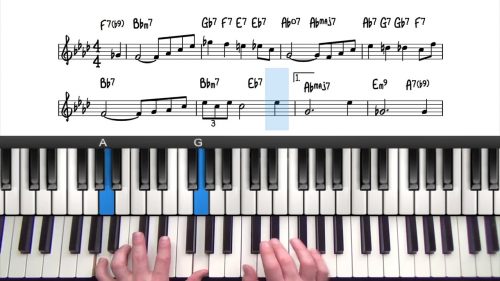The Days Of Wine & Roses Improvisation
In this lesson we’ll analyse 2 solos that I’ve transcribed over the form of “The Days Of Wine & Roses”. We deconstruct these solos to gain insight into improvisation.
Below you can find the links to the recordings on Spotify and on iTunes.
Check out the lesson on “The Days Of Wine & Roses” before watching this lesson.
You should be able to play the tune without looking at the lead sheet, so you
know the chords and melody by memory. You should also be able to play through with left hand voicings.
Then you will have the foundations in place to start exploring the tune from an improvisation standpoint.
Both of the solos I have transcribed are 16 bars long and they take you through the A and B Sections. Remember that the form of the tune is A-B-A-C.
As an exercise, have a go at transcribing more material from these solos, or
alternatively pick your own tunes to work on.
“The Days Of Wine & Roses” is a nice tune to work on because it has lots of 25 progressions and it’s important to develop material to play over this common progression
Solo 1: “Atlantic 5 Jazz Band – Days Of Wine & Roses”
-
iTunes: album here
-
Spotify: recording here
Solo 2: “Beegie Adair – Days Of Wine & Roses”
-
iTunes: album here
-
Spotify: recording here
Practice Tips
-
After you’ve transcribed a line over a 251, analyse it numerically and then apply it to other keys. Remember that it will work better in some keys than others. Generally it will be easy to transpose it to neighboring keys on the circle of fifths, so that’s a good place to start.
-
Try and find an example of the same progression in a different tune and then play your new line over the chords changes.
-
The next step is to play the transposed version over a chord progression in a different tune.
-
By following these steps, you will gain a much better understanding of the line and how to apply it in different situations and in different keys.
-
A final point is to pay attention how the head of the tune transitions into the solo.
-
As an exercise, have a go at transcribing more material from these solos, or alternatively pick your own tunes to work on.
-
"The Days Of Wine & Roses" is a nice tune to work on because it has lots of 25 progressions and it’s important to develop material to play over this common progression





Hi there Hayden!
Do you by any chance have the transcriptions written out? I have had a go at writing them out myself and it would be great to compare notation,
Many thanks,
Jamie
Hi Jamie 👋🏻
I didn’t notate the transcription when creating this lesson but I have added it to my to-do list.
I agree it would be a nice addition as a download.
In case you haven’t seen the transcription area in the forum, we have a lot ear training and transcription exercises there which all include notation: https://www.pianogroove.com/community/c/improvisation-exercises/30
We also have our “Jazz Piano Legends” course which contains lots of transcriptions and transcribed material: https://www.pianogroove.com/jazz-piano-lessons/jazz-piano-legends-series/
Hope this helps Jamie and leave the transcription notation with me. It’s really great that you are getting involved in transcription by the way; it’s by far the most time effective was to learn improvisation.
Cheers! Hayden
Thanks Hayden, this is super helpful!
Jamie
Hayden,
Here is a question that has been bugging me for some time now.
I have done a number of transcriptions now and have some nice licks that I am slowly applying to tunes.
How do I handle the following three examples of 2-5 chord progressions which are found throughout many tunes and especially The Days of Wine and Roses which I am working on memorizing and improvising on.
I don’t think that these are minor 251s because there is no minor7(b5) chord. But are they major 251s?
What do I do? How do I think about these and apply them to other tunes? Are these three different types of 25s and should I apply each one where I find one just like it in another tune? Or should I modify the lick to fit the new song? What’s the simplest thing to do?
On the other hand, maybe when you say major 251, do you mean only these:
Your help would be appreciated as I am working at this pretty hard. 251s here, 251s there, 251s everywhere…
Thanks,
Brad
Hayden,
Please, there is now no need to reply to my prior questions. I think I figured it out.
A nice phrase over a major 25 can also be played over the relative minor 25 and vice versa
A nice phrase over the major I chord can also be played over the major 25 and vice versa
A nice phrase over the minor I chord may also work over the minor 25 and vice versa
As for 25s that are neither major nor minor, I will take them more on a case by case basis, if they are nice enough I will modify them to work on a 25 or not.
I have already transcribed plenty of good material and can apply it in more places knowing the above statements.
One more thing I noticed in Wynton Kelly’s Freddie Freeloader solos is that he sometimes uses a major triad arpeggio over a dominant chord, like playing a Bb major arpeggio over Ab7. So I am going to try applying upper structure triads arpeggios in some of my improvs where they sound good.
Brad
HI Brad,
Apologies for the late reply here.
Hi Brad,
Apologies for the late reply here.
For Am7 D7 Gm7: Pay attention to your point of resolution into the 1 chord. It sounds very nice to resolve into the 9th of the i-7 chord. The chords tones 3-5-7 are also strong points of resolution.
By the way this is a minor 251; if the 1 chord is minor it’s a minor 251 progression, and if that 1 chord is major it’s a major 251 progression. We can have a major 251 with a -7b5 for the 2 chord, and vice-versa we can have a minor 251 with a regular minor 2 chord. We name the progression by the 1 chord “251 of the 1 chord”
For Am7 Dm7 Gm7 and/or Am7 Dm7 We can always play that Dm7 as a D7 when improvising. This might not work with the melody note on the lead sheet but when improvising our own phrases we have the creative freedom to play chords as dominant voicings – particularly like this when they are built a 5th apart A > D > G.
You can also play minor lines over the Dm7, again because these chords are a 5th apart they share a lot of common notes and so it’s easy to connect the chord tones.
I hope that helps Brad – let me know if you have any other questions on this.
Cheers, Hayden
ps. congratulations on your progress with transcription. I am working a new course which contains 10 transcribed 251 lines and we learn them, transpose them, and apply to jazz standards. I will post updates in the forum.